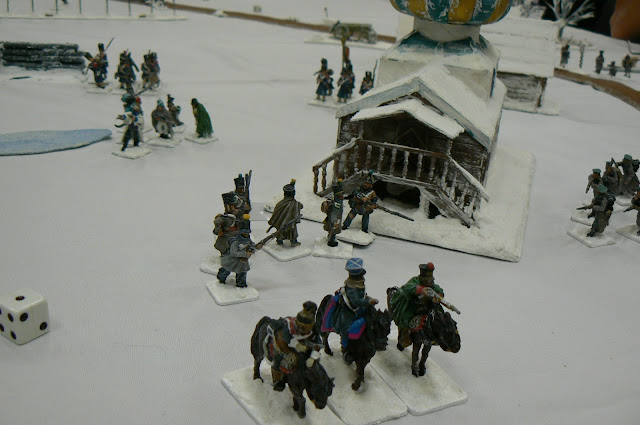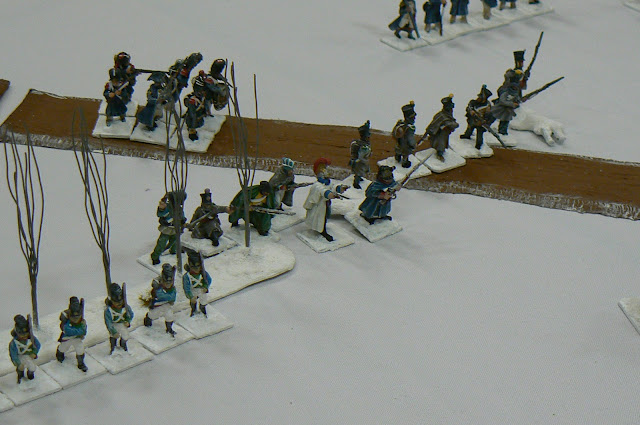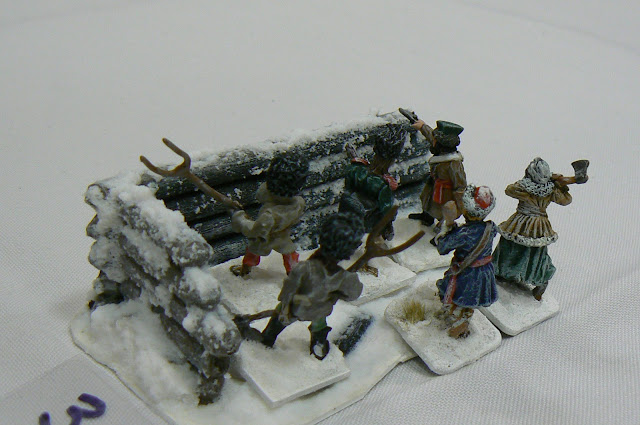The first of my three games I hosted at the Enfilade! convention in Olympia, Washington State USA, was a “Retreat from Moscow” affair conceived after learning the convention’s ‘winter’ theme, the fortuitous acquisition of the beautiful Perry sculpts, the ownership of a large white sheet which could be a tract of snow covered tabletop, and the re-conceiving of the church which I previously constructed but with which I was not entirely happy so I was quite willing to cover it modelled snow - all the parts of which a miniatures game may be made; except for the lack of the rules.

I am a firm believer that all convention games, with the accompanying noise level, player inexperience, and general confusion, must be of a simplistic level to work and be fun to play. So I made these really simple! If the participants are not playing the game unaided by the fourth turn, the rules are too challenging! Generally 6s to hit, movement by standard stick, shooting range by the same, blob movement, no formations and above all, no morale. “Morale”, the mental state of which our metal miniature representative conduct human emotional responses to combat situations on the tabletop can be the bane of rule writers and players alike…so I just said there are none. Units will continue until no figures remain. None got to that stage in this game….some were close however!
As my game write up suggests, “
To surrender is to be killed, to give up is to die frozen, to run away is to die alone in the white vastness. Your only option is to fight and keep walking but that the Russians and nature may not allow. It's fun in the snow!! Simple rules for a simple game!”
I had 7 players controlling their small units of either 6 foot or 3 horse of the retreating Grand Armee including Poles, Bavarians, French and a group of various other nations (for which the Perrys made) verses the Russian defenders of jagers and Cossacks but mainly small groups of armed peasants.
 |
| (l-r) Bavarians, French cav on foot, French infantry and on road, one unit of Old Guard |
All the aspects of the game are random, including the use of hidden cards indicating who next chooses his - or her - unit. I had the two players who picked the jagers or Cossacks also move and roll for the peasants on their side of the table to speed up play. The game flowed along with all the French players making it across the rather rickety bridge (a chance for figures falling to their deaths in the frozen river ) and “victory” in safety off the table.
At first, most players were under the belief that it would be a very difficult task, as I suggested even by crossing some of the terrain could kill them; but, by the end of the game, they were suggesting for more dangerous approaches for the Retreaters! As with randomness, sometimes the aspects were not that dangerous with the dice rolls; my favourite, the wild boars, proved rather ineffective on both occasions (!) and being shot with good musket fire so not having the chance to get their teeth into either French or Russian flesh.

Russian peasant group in a 'staging area'
I was a bit surprised being judged best of session theme winner, and handed out the swag I was presented - small flashlight measure, tape/bottle-opener combo etc. - to the players first over the bridge as a bit of a reward for their play.
